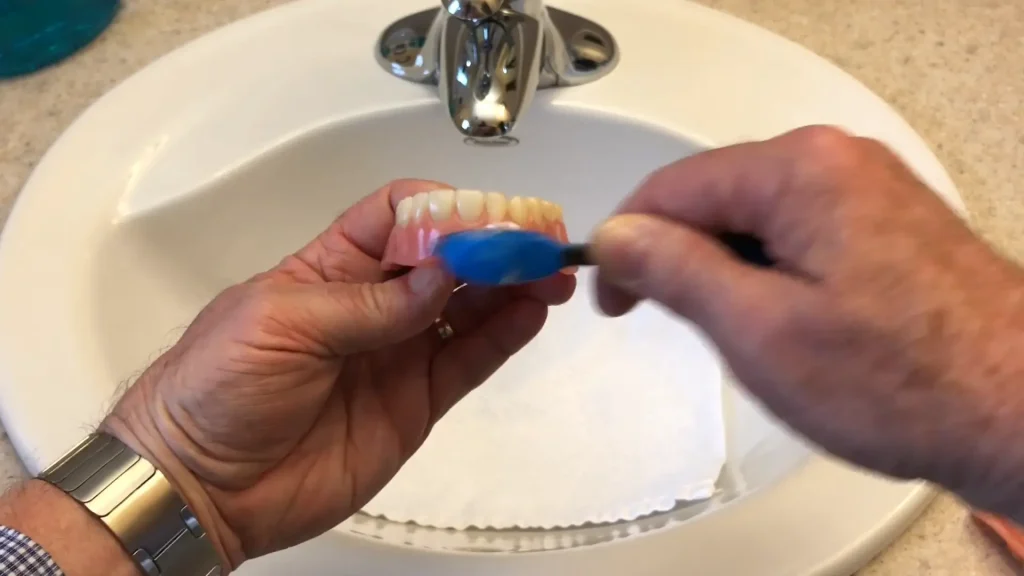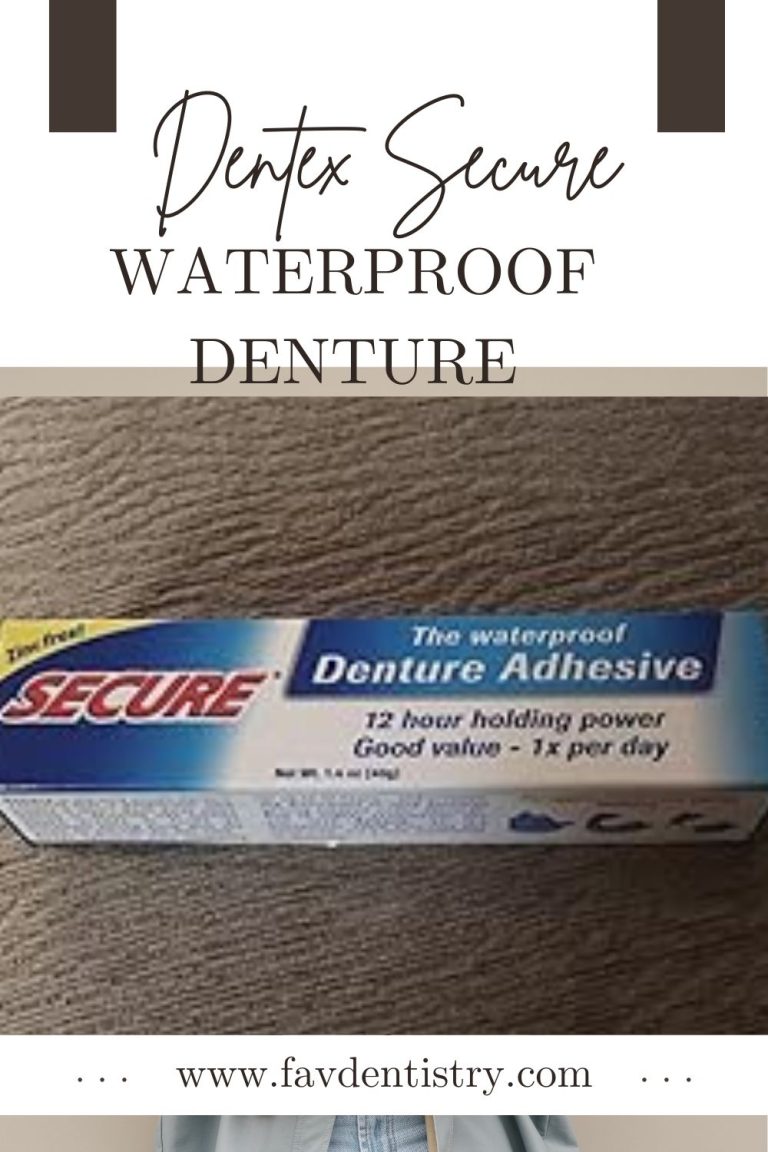How to Remove Denture Adhesive: Quick & Easy Tips
Last Updated on 7 months by DR. ALBIN SIPES
To remove denture adhesive, gently swish warm water in your mouth and use a soft toothbrush to clean your gums and the roof of your mouth. Then, use a damp washcloth or gauze to wipe away any remaining adhesive residue.
When wearing dentures, using adhesive can provide stability and comfort. However, removing the adhesive properly is essential for maintaining oral hygiene. Denture wearers should follow a simple yet effective process to ensure the residue is completely removed without causing any damage to the gums or dentures.
We will explore the best methods for removing denture adhesive and provide tips for maintaining good oral health while wearing dentures.
Introduction To Denture Adhesive
Denture adhesive is a product designed to help keep dentures in place and improve their stability. It is a popular solution for individuals who experience difficulties with denture movement or slippage during everyday activities such as eating and speaking.
Why use adhesive?
Using denture adhesive can provide several benefits, including:
- Enhanced denture stability: Adhesive helps to create a strong bond between the denture and the gums, reducing movement and improving overall comfort.
- Improved confidence: With dentures securely in place, individuals can feel more confident and worry less about embarrassing slips or clicking noises.
- Better chewing and speaking abilities: Adhesive can help to improve the functionality of dentures, allowing for easier chewing of food and clearer speech.
| Type | Description |
|---|---|
| Zinc-free adhesive | Does not contain zinc, which can cause adverse reactions for some individuals. |
| Powder adhesive | A fine powder that transforms into a sticky paste when mixed with saliva. |
| Cream adhesive | A creamy substance that provides a strong hold and is easy to apply. |
When considering denture adhesive, it’s important to choose the right type based on personal preferences and any specific needs or sensitivities.
Preparing For Removal
Before removing denture adhesive, gather the necessary supplies such as adhesive remover, a soft-bristled toothbrush, and a washcloth. Rinse your mouth with warm water to loosen the adhesive. Use a pea-sized amount of adhesive remover on the denture and gently brush it with the toothbrush. Avoid using hot water as it can damage the dentures. Rinse the dentures thoroughly and clean them with a washcloth. Ensure that no adhesive residue remains on the dentures. Properly store the dentures in a denture cleaning solution or water when not in use. Repeat this process as needed to effectively remove all adhesive residue.
Methods To Remove Denture Adhesive From Mouth
When removing denture adhesive from your mouth, start with a warm water rinse to loosen the adhesive. Gently swish warm water around your mouth and then spit it out. Next, consider soaking your mouth with mouthwash to help break down the adhesive. Allow the mouthwash to sit in your mouth for a minute or two before spitting it out. Finally, use a soft toothbrush to gently brush the inside of your mouth to remove any remaining adhesive. Be sure to brush gently to avoid irritating your gums. Repeat these steps as needed until the adhesive is completely removed.
Cleaning Your Dentures After Adhesive Removal

After removing denture adhesive, it is important to clean your dentures thoroughly to maintain their hygiene and prolong their lifespan. One effective method is soaking your dentures in a denture cleaner. This helps to remove any remaining adhesive residue and eliminate bacteria and odors.
When soaking your dentures, follow the instructions on the denture cleaner packaging. Ensure that you use a cleaner specifically designed for dentures to avoid damaging the material. Soaking time may vary, but generally, a few minutes to overnight is recommended.
After the soaking process, it is essential to brush your dentures using a soft-bristle toothbrush. This helps to remove any loosened debris and further clean the surface. Be gentle when brushing to avoid damaging the dentures.
Regularly cleaning your dentures after adhesive removal will help prevent the buildup of bacteria and maintain their appearance and functionality. Remember to follow the instructions provided by your dentist or denture specialist for the best care practices.
Removing Adhesive Residues From Gums
When removing denture adhesive residues from your gums, it is important to use gentle brushing techniques to avoid any discomfort or damage. Start by rinsing your mouth with warm water to loosen the adhesive. Then, use a soft-bristled toothbrush to gently brush your gums in a circular motion, focusing on the areas where adhesive residue is present. Avoid using excessive force or scrubbing too hard, as this can irritate your gums.
Additionally, there are safe products available specifically designed for gum cleaning. These products are formulated to effectively remove adhesive residues without causing any harm to your gums. Look for products that are alcohol-free and gentle on the gums. Follow the instructions provided by the manufacturer for the best results. Regularly cleaning your gums and removing adhesive residues will help maintain oral hygiene and prevent any potential issues.
Caring For Your Dentures
Dentures are an essential part of your daily routine if you have lost your natural teeth. It is essential to take care of your dentures to ensure their longevity and to avoid any discomfort. Here are some daily maintenance tips to keep your dentures in good condition:
- Remove your dentures and rinse them after each meal.
- Brush your dentures daily with a soft-bristled brush and mild soap or denture cleaner.
- Soak your dentures overnight in a denture solution or water. Do not use hot water as it can warp your dentures.
- Before wearing your dentures, rinse them thoroughly with water to remove any leftover cleaning solution.
Storing your dentures properly is also important to maintain their shape and hygiene. Here are some tips to store your dentures:
- Place your dentures in a denture cup or container filled with water or a denture solution.
- Do not let your dentures dry out as they can lose their shape and become brittle.
- Keep your denture cup or container in a safe and clean place where it cannot be accidentally knocked over or damaged.
Troubleshooting Common Issues
Looking for ways to remove denture adhesive? Troubleshooting common issues with denture adhesive can be a hassle, but with these simple tips, you’ll be able to remove it easily and efficiently. Say goodbye to sticky situations and enjoy a comfortable fit with your dentures.
| Troubleshooting Common Issues |
|---|
| Dealing with stubborn residues |
| If you are having trouble removing denture adhesive, try using a denture adhesive removal solution. These solutions can help dissolve the adhesive, making it easier to remove. You can also try using a soft-bristled toothbrush or a denture brush to gently scrub away any remaining adhesive. |
| Managing irritation from adhesives |
| If you experience irritation from denture adhesive, try using a zinc-free adhesive or a sensitive skin formula. You can also try using less adhesive or switching to a different brand. If the irritation persists, consult with your dentist or healthcare provider. |
Professional Help And Advice
Professional help and advice can be sought when it comes to removing denture adhesive. If you are unsure about the process or experiencing any difficulties, it is recommended to see a dentist. Dentists have the expertise and tools to assist you in safely and effectively removing denture adhesive. They can provide professional cleaning services and guidance on the best practices for denture care. Whether you have residual adhesive on your dentures or are struggling with the removal process, a dentist can offer the necessary assistance. It is important to remember that denture adhesive should be used as directed and any concerns should be addressed promptly to avoid any potential complications.
Conclusion
Removing denture adhesive can be a daunting task, but with the right tools and techniques, it can be done easily. From using warm water and soap to specialized adhesive removers, there are several ways to remove denture adhesive effectively. It’s essential to follow the instructions carefully and avoid using harsh chemicals that can damage your dentures.
By following these tips and tricks, you can keep your dentures clean and free from any adhesive residue, ensuring a comfortable and secure fit.
Also read – 3 ways to apply denture adhesive


